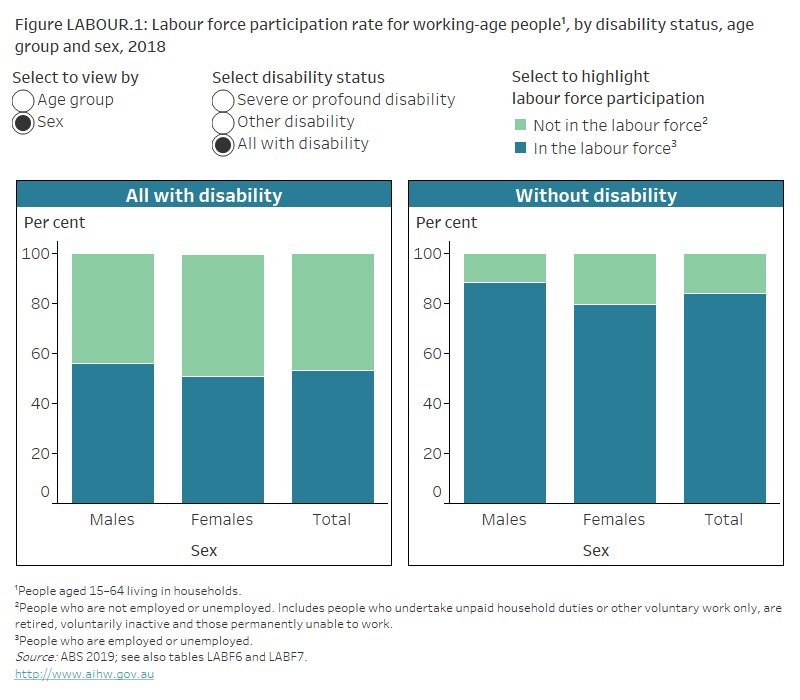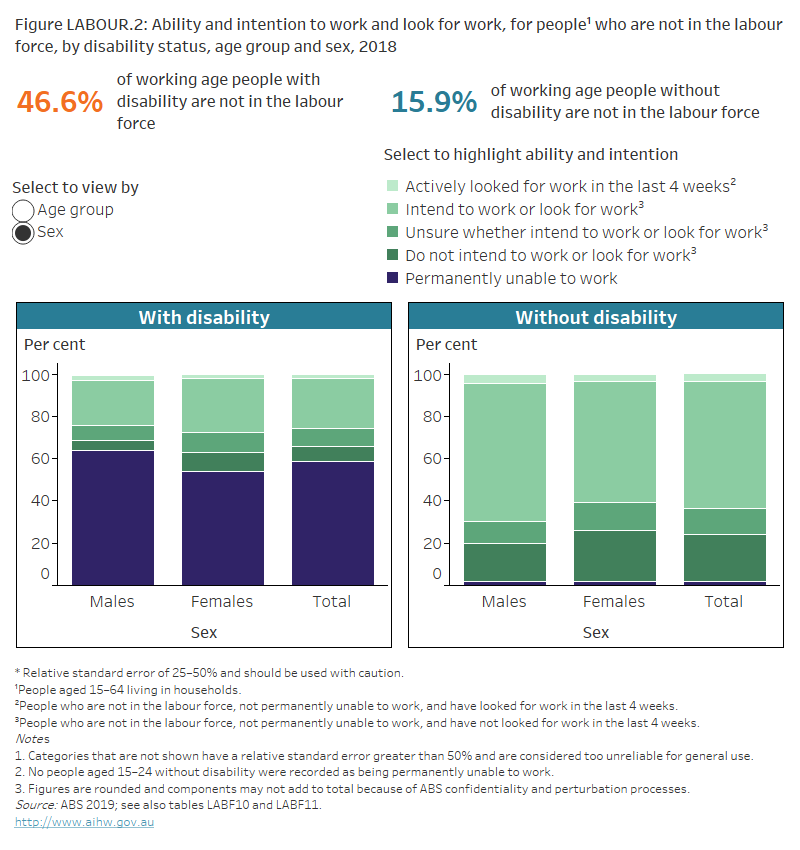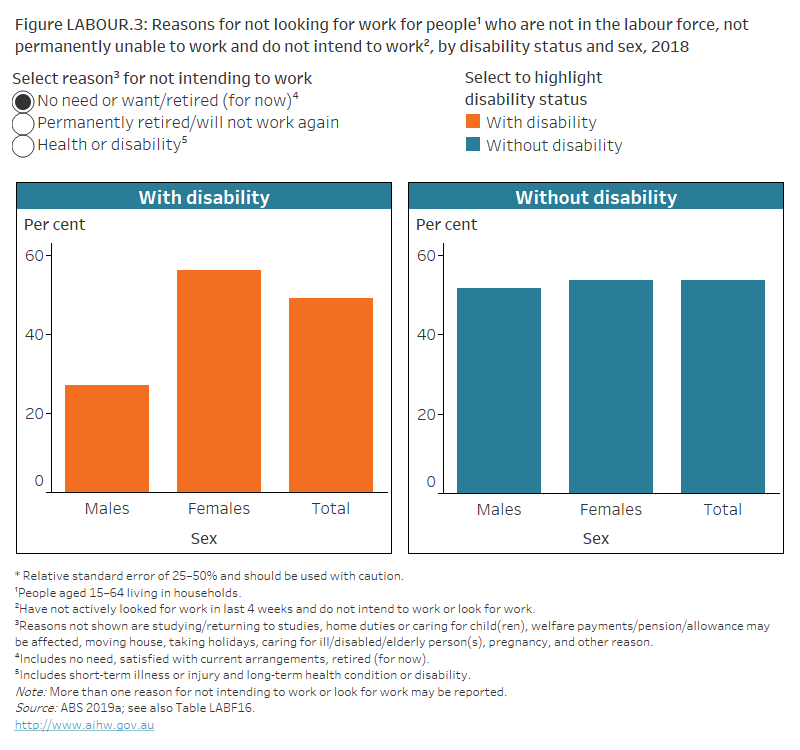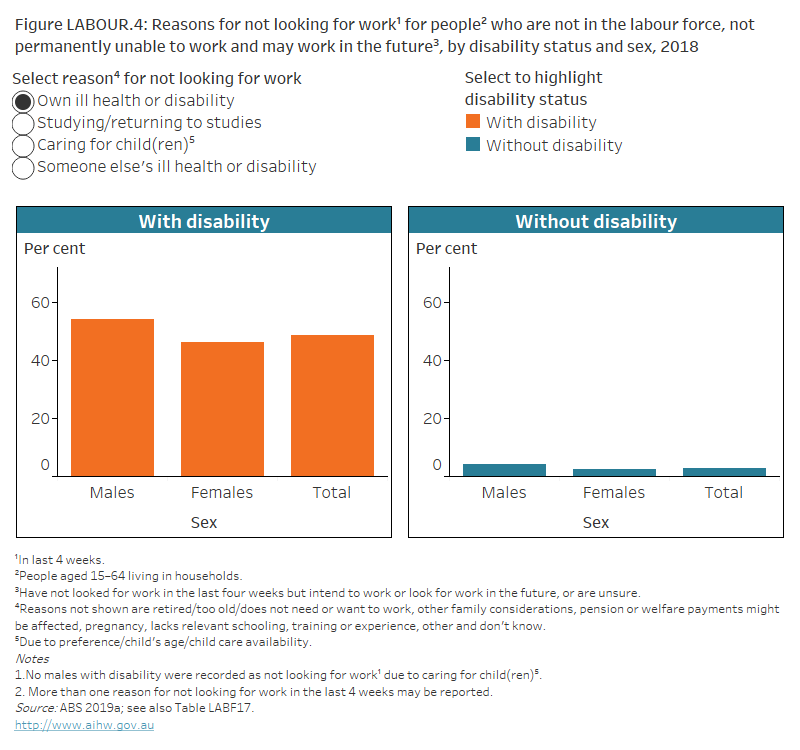Labour force participation
53%
of working-age people with disability are in the labour force, compared with 84% of those without disability
27%
of people with severe or profound disability are in the labour force, compared with 62% with other disability
59%
of working-age people with disability who are not in the labour force are permanently unable to work
On this page:
Introduction
More than 1 million working-age people with disability are working or looking for work (are in the labour force). This has remained stable over 15 years – 53% of people aged 15–64 with disability participated in the labour force in 2018 (or 1.1 million) and 2003 (or 1.2 million). Among those with severe or profound disability 27% were in the labour force in 2018 and 30% in 2003 (ABS 2019).
How is labour force participation defined?
People who are in the labour force include those aged 15–64 who are employed or unemployed.
In the labour force:
- people who are employed include those who reported in the SDAC that they had worked in a job, business or farm during the reference week (the full week before the date of their survey interview); or had a job in the reference week, but were not at work
- people who are unemployed include those who reported in the SDAC that they were not employed during the reference week, and had actively looked for full- or part-time work at any time in the 4 weeks up to the end of the reference week and were available for work in the reference week.
Not in the labour force:
- people who are not employed
- people who are not unemployed.
This includes people who undertake only unpaid household duties or other voluntary work, those who are retired, voluntarily inactive and those permanently unable to work (ABS 2018).
Survey of Disability, Ageing and Carers
Data in this section are sourced from the Australian Bureau of Statistics’ (ABS) 2018 Survey of Disability, Ageing and Carers (SDAC). The SDAC is the most detailed and comprehensive source of data on disability prevalence in Australia.
The SDAC considers that a person has disability if they have at least one of a list of limitations, restrictions or impairments, which has lasted, or is likely to last, for at least 6 months and restricts everyday activities.
The limitations are grouped into 10 activities associated with daily living – self-care, mobility, communication, cognitive or emotional tasks, health care, reading or writing tasks, transport, household chores, property maintenance, and meal preparation. The SDAC also identifies 2 other life areas in which people may experience restriction or difficulty as a result of disability – schooling and employment.
The severity of disability is defined by whether a person needs help, has difficulty, or uses aids or equipment with 3 core activities – self-care, mobility, and communication – and is grouped for mild, moderate, severe, and profound limitation. People who always or sometimes need help with one or more core activities, have difficulty understanding or being understood by family or friends, or can communicate more easily using sign language or other non-spoken forms of communication are referred to in this section as ‘people with severe or profound disability’.
People aged 65 and over
Most (88% or 1.1 million) people with disability who participate in the labour force are aged 15–64. The rest are aged 65 and over (159,000).
People aged 15–64 are referred to as ‘working-age’ in this section.
With increasing life expectancies and improvements in health care, today’s Australians will grow older and live longer, healthier and more actively engaging lives than any previous generation (AIHW 2017). The eligibility age for the Age Pension is also increasing. For some older people, including those with disability, these factors may mean staying longer in the workforce.
Labour force participation rate
People with disability have a lower labour force participation rate than people without disability. Just over half (53% or 1.1 million) of working-age people with disability are in the labour force, compared with 84% (or 11.8 million) without disability. This is particularly so for those with severe or profound disability (27% or 137,000 compared with 62% or 960,000 with other disability).
Labour force participation rate
The labour force participation rate is the number of working-age (aged 15–64) people who are employed or unemployed as a percentage of the working-age population.
Generally, males are more likely to be in the labour force than females (Figure LABOUR.1). This is true for people with and without disability:
- 56% (or 563,000) of working-age males with disability, compared with 51% (or 535,000) of females
- 89% (or 6.2 million) of working-age males without disability, compared with 80% (or 5.6 million).
Similarly, for those with severe or profound disability 31% (or 76,000) of males with disability are in the labour force compared with 24% (or 61,000) of females (ABS 2019).
Figure LABOUR.1: Labour force participation rate for working-age people, by disability status, age group and sex, 2018
Stacked column chart showing labour force participation for working-age people with and without disability. The reader can select to display the chart by sex or age group and by disability status. The chart shows people with disability aged 25–64 are less likely (54%) to participate in the labour force than those without disability (87%).

Source data tables: Labour force participation (XLSX, 180KB)
Working-age people with sensory and speech disability (55% or 225,000) and physical disability (49% or 632,000) are more likely to be in the labour force than those with head injury, stroke or acquired brain injury (32% or 51,000) and psychosocial disability (33% or 215,000) (ABS 2019).
Disability group
Disability group is a broad categorisation of disability. It is based on underlying health conditions and on impairments, activity limitations and participation restrictions. It is not a diagnostic grouping, nor is there a one-to-one correspondence between a health condition and a disability group.
The ABS SDAC broadly groups disabilities depending on whether they relate to functioning of the mind or the senses, or to anatomy or physiology. Each disability group may refer to a single disability or be composed of a number of broadly similar disabilities. The SDAC identifies 6 separate groups based on the particular type of disability; these are:
- sensory and speech (sight, hearing, speech)
- intellectual (difficulty learning or understanding)
- physical (including breathing difficulties, chronic or recurrent pain, incomplete use of limbs and more)
- psychosocial (including nervous or emotional conditions, mental illness, memory problems, and social or behavioural difficulties)
- head injury, stroke or acquired brain injury
- other (restrictions in everyday activities due to other long-term conditions or ailments) (ABS 2019).
Reasons for not being in the labour force
Close to half (47% or 959,000) of all working-age people with disability are not in the labour force. Of these:
- most (59% or 562,000) are permanently unable to work
- almost a quarter (23% or 224,000) intend to work or look for work
- 1 in 12 (8.7% or 83,000) are unsure if they intend to work or look for work
- 1 in 15 (6.9% or 67,000) do not intend to work or look for work (Figure LABOUR.2).
This varies by age and sex (Figure LABOUR.2).
Working-age people with disability who are not in the labour force are far more likely than those without disability to be permanently unable to work (59% or 562,000 compared with 2.1% or 48,000). They are also much less likely to intend to work or look for work (23% or 224,000 compared with 60% or 1.3 million).
Figure LABOUR.2: Ability and intention to work and look for work, for people who are not in the labour force, by disability status, age group and sex, 2018
Stacked column chart showing ability and intention to work and look for work for people not in the labour force with and without disability. The reader can select to display the chart by sex and by age group. The chart shows people with disability aged 25–44 are less likely (34%) to intend to work or look for work than those without disability (71%).

Source data tables: Labour force participation (XLSX, 180KB)
About two-thirds (67% or 64,000) of working-age people with disability who are not in the labour force and live in Outer regional and remote areas are permanently unable to work compared with those living in Major cities (54% or 329,000).
How is remoteness defined?
The remoteness categories used in the ABS SDAC are defined by the Australian Statistical Geography Standard Remoteness Structure (ABS 2016) which divides Australia into 5 classes of remoteness on the basis of a measure of relative access to services. Very remote areas are out of scope for the SDAC.
People who are permanently unable to work
Of working-age people with disability who are permanently unable to work:
- 9 in 10 (91% or 511,000) said it was because of their own condition or disability
- 1 in 7 (12% or 70,000) said it was because of someone else’s ill health or disability.
When asked about requirements to enable workforce participation, 96% said they could not work at all. Some reported they may be able to participate if certain requirements were met, such as training, equipment and assistance with work or personal care tasks (2.8% or 16,000) (ABS 2019).
People able to work
People able to work refers to working-age people not permanently unable to work.
People who do not intend to work or look for work
Of working-age people with disability able to work but not intending to work or look for work:
- half (49% or 33,000) have no need to work, are satisfied with current arrangements or are retired (for now)
- 32% (or 21,000) are permanently retired or will not work again
- 18% (or 12,000) cited their short-term illness or injury or long-term health condition or disability (Figure LABOUR.3).
Males with disability able but not intending to work (42% or 9,000) are much more likely than their female counterparts (26% or 12,000) to report they are permanently retired or will not work again (ABS 2019).
Figure LABOUR.3: Reasons for not looking for work for people who are not in the labour force, not permanently unable to work and do not intend to work, by disability status and sex, 2018
Column chart showing the reasons for not intending to work for working-age males and females who do not intend to work, with and without disability. The reader can select to display the chart by 3 reasons for not intending to work. The chart shows males with disability are more likely (42%) to be permanently retired or state they will not work again than those without disability (28%).

Source data tables: Labour force participation (XLSX, 180KB)
People who may work in the future
People who may work in the future are those who:
- have not looked for work but intend to work or look for work
- are not sure if they will work.
Their most common reasons for not looking for work in the last 4 weeks are:
- own ill health or disability (49% or 145,000)
- studying or returning to study (28% or 85,000)
- children too young or prefer to look after them and child care availability (13% or 39,000)
- someone else’s ill health or disability (11% or 33,000) (Figure LABOUR.4).
Figure LABOUR.4: Reasons for not looking for work for people who are not in the labour force, not permanently unable to work and who may work in the future, by disability status and sex, 2018
Column chart showing the reasons for not looking for work in the previous 4 weeks for working-age males and females who may work in the future, with and without disability. The reader can select to display the chart by 4 reasons for not looking for work. The chart shows females with disability are more likely (12%) to state someone else’s ill health or disability than those without disability (7.1%).

Source data tables: Labour force participation (XLSX, 180KB)
Differences in reasons between males and females with disability who may work in the future are similar to those for people who do not intend to work or look for work. For example, of working-age people with disability who may work in the future:
- males are more likely than females to give their own ill health or disability as a reason for not looking for work – 54% (or 67,000) compared with 46% (or 81,000)
- males are more likely to report studying or returning to studies as a reason – 32% (or 40,000) compared with 27% (or 47,000)
- females are likely to cite family or relationship considerations as reasons for not looking for work
- children being too young or preferring to look after them and child care availability – 21% (or 37,000) of females
- someone else’s ill health or disability – 12% (or 21,000)
- other family considerations – 9.7% (or 17,000) (ABS 2019).
Labour force status case study
In 2019 Mission Australia conducted a survey of young people (aged 15–19) including a cluster of questions focused on disability. In Mission Australia’s Youth Survey 2019, 6.5% (or 1,600) of young people reported having disability and 91.3% (or 23,100) reported no disability.
Young people who reported having disability are:
- less likely to be working part-time (31%) than those without disability (44%)
- more likely to not be in paid employment but looking for work (40% compared with 34%)
- more likely to be neither working nor looking for work (27% compared with 21%).
Note: part-time employment is considered to be less than 35 hours a week, while full-time employment is considered to be 35 hours or more (Hall et al. 2020).
Where can I find out more?
Data tables for this report.
ABS Disability, Ageing and Carers, Australia: Summary of Findings, 2018
ABS (Australian Bureau of Statistics) (2018) Australian Statistical Geography Standard (ASGS): Volume 5 – remoteness structure, July 2016, ABS cat. no. 1270.0.55.005, ABS, accessed 16 September 2021.
ABS (2018) Labour statistics: concepts, sources and methods, February 2018, ABS cat. no. 6102.0.55.001, ABS, accessed 3 August 2021.
ABS (2019) Microdata: disability, ageing and carers, Australia, 2018, ABS cat. no. 4430.0.30.002, AIHW analysis of TableBuilder data, accessed 3 August 2021.
AIHW (Australian Institute of Health and Welfare) (2017) Australia’s welfare 2017, Australia’s welfare series no. 13, cat. no. AUS 214, AIHW, accessed 3 August 2021.
Hall S, Fildes J, Liyanarachchi D, Plummer J and Reynolds M (2020) Young, willing, and able – youth survey disability report 2019, Mission Australia, Sydney, accessed 24 November 2021.


